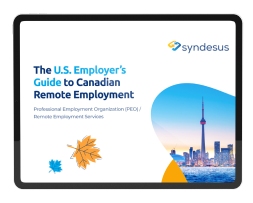The US immigration process can be lengthy and create uncertainty for both foreign-born employees and their US employers. Several H-1B challenges are facing the tech sector, including bid caps, weighted lottery, and competition between tech giants, putting tech workers at risk of visa denials and expirations every year.
We recently hosted a webinar with US immigration lawyer Sameer Khedekar, Canadian immigration attorney Daniel Mandelbaum, and Syndesus Founder & CEO Marc Pavlopoulos. The webinar was aimed at tech workers looking to remain in the US, remain in Canada, or go between Canada and the US using boomerang immigration strategies.
Daniel discussed Canadian immigration including work visas, citizenship pathways, and two ways tech workers can move to Canada.
Marc discussed how Employer of Record (EOR) and Professional Employer Organization (PEO) services can help you to move your employees to Canada using these programs and what you can do if your employer won’t allow you to work remotely from Canada.
Lastly, Sameer covered long-term strategies, such as moving back to the US one day, which we call boomerang strategies.
An overview of the Boomerang Immigration Strategy webinar is provided below, including information on how tech workers and employers of tech workers can benefit from Canada’s favorable immigration laws.
How the Global Talent Stream enables tech workers to live In Canada
Foreign-born tech workers who have come to the US to pursue the American Dream are often faced with uncertainty due to a challenging immigration system that offers no guarantee of citizenship or permanent residency.
Many tech workers have begun to seek work visas in Canada because the country offers a world-class immigration system that allows them to gain Canadian citizenship rapidly.
PR can be obtained in just six months using the Express Entry System which draws from a pool of qualified candidates and works on a point-based system.
The first step for tech workers looking to move to Canada is to get a temporary work permit through what is called the Global Talent Stream (GTS). As long as you earn a wage equivalent to what a Canadian in that job would earn, you can obtain a work permit as a tech worker.
It’s not just software engineers and developers who qualify for GTS – everything from business analysts to data scientists to digital media designers.
Since many tech workers interested in GTS also want H-1B visas, it’s important to explain how GTS differs from the H-1B route. Namely:
- A Canadian work visa does not have a cap, while the H-1B visa has an annual one
- There is no lottery system for applicants who submit a GTS application.
- Temporary and permanent visa programs are available online
- There are no quotas based on country of origin for eventual permanent residency applications.
One of the main benefits of the Global Talent Stream program is the clear pathway to permanent residency (PR) in Canada. PR can be obtained in just six months using the Express Entry System which draws from a pool of qualified candidates and works on a point-based system.
...eligibility for citizenship in Canada is available within three years and takes around a year to process which is much quicker than in many other countries, including the US...
In addition, if a candidate isn’t successfully drawn via the Express Entry System, there are other options, such as Provincial Nominee Programs (PNPs), which are unique immigration programs for specific Canadian provinces.
This option offers a pathway to permanent residency via sponsorship by a province of Canada, given that the applicant intends to reside in that province.
Some provinces are open for anyone to apply (known as an open system), and some provinces require that you express interest and await an invitation (known as a closed-competitive system).
Finally, eligibility for citizenship in Canada is available within three years and takes around a year to process which is much quicker than in many other countries, including the US, and can open many doors to individuals as dual citizens.
US-based tech professionals have two easy ways to move to Canada
For individuals who have a job offer for a US employer but are facing H-1B visa challenges and are running out of time, there are two main ways forward.
Work remotely in Canada for your US employer
EORs – like Syndesus – can sponsor tech professionals’ work visas in Canada as third-party employers, allowing them to work for US employers remotely from Canada. The EOR handles all the technical aspects of Canadian employment, for example, HR, taxes, payroll, health care, and, importantly, immigration.
The employee will have the same job, the same title, and the same boss as if they were working on-site in the US, but instead of dealing with the uncertainty around the H-1B visa, they will be able to obtain a Canadian work permit in less than 90 days — a welcome change for those who are familiar with the H-1B process.
The employee can later apply for permanent residency or citizenship in Canada and either stay working for the American employer or look for new employment within Canada down the line. Plus, a Canadian visa automatically comes with an open work visa for the applicant’s spouse who will be able to work for any Canadian company.
If you as a tech worker were able to obtain an H-1B visa before leaving the US, you could also use that H-1B for intermittent work in the US while waiting for your Canadian citizenship.
To work with a Canadian EOR, there are some eligibility requirements:
- You need to qualify for the Global Talent Stream
- Your job needs to be 100% remote
- Your US company needs to agree, pay all fees, and sign the appropriate paperwork
- You and your US employer must commit to going through the Canadian immigration process and put US immigration on hold, at least in the short-term
Find a tech job with a Canadian employer
For tech professionals whose US employers may be unable or unwilling to move their job to Canada via an EOR, another great option is to get a tech job with a Canadian employer. This helps tech professionals avoid many of the long-term challenges that H-1B workers face, including a long backlog for obtaining a US permanent residency, particularly for individuals from India.
One easy way of doing this is to leverage Syndesus’ Path to Canada service, which connects talented tech workers that are vetted and considered strong candidates for a GTS work permit with Canadian companies that are eager to hire tech talent. Path to Canada guides the candidate every step of the way, from finding a job to moving and getting set up in Canada with their family.
Unlike the H-1B, the GTS work permit is quick — within a month candidates can typically start their new life in Canada with a clear pathway to Canadian citizenship in around five years.
Once you’re a Canadian citizen you can “boomerang” back to the US
Becoming a Canadian citizen opens a lot of options. Canada may be your new forever home, but if you do dream of returning to the US, there are some great strategies you can utilize.
TN visa
The first option, only available to Canadian and Mexican citizens, is to obtain a TN Visa. Like the H-1B, you need to have a qualifying degree, work experience, and job offer (such as a software engineer) though there is no minimum wage requirement. The TN visa is also flexible in terms of where in the US you can live and apply, which is much easier than the H-1B visa – you can apply at an airport in Canada, at a port of entry on the ground, or online.
H-1B visa
If you want to go down the H-1B route again, you will find it is now significantly easier because Canadian citizens don’t require visa stamps from a consulate abroad. Canada is the only country in which this is the case.
O-1 visa
This could be a great option now for individuals who accrue several years of work experience in Canada and build specific expertise in their area of work. In such cases, you may consider applying for the O-1 extraordinary ability visa, which provides work authorization, doesn’t have an annual cap, and can even be self-petitioned, without a specific US employer. For example, if you have become a critical employee in your company, publish academic or other materials, win awards, or make meaningful contributions within your field, you make be eligible for an O-1 visa.
EB-1A green card
Finally, a self-petition green card, like the O-1 visa, is possible. In theory, this is the best option since it leads directly to permanent residency, however, that also means that there are additional layers of scrutiny involved. You can start working towards meeting the criteria for the EB-1A, which are like those needed for an O-1 visa, as soon as you arrive in Canada. At the end of the day, even if it doesn’t work out, the steps you take to build an EB-1A application can help your career in the long run.
Whichever one of these routes you consider, rest assured that once you become a Canadian citizen, you will be able to keep your Canadian citizenship even if you decide to move back to the US.
Learn more about relocating to Canada with Syndesus
If you’re interested in moving to Canada as a tech worker Syndesus has solutions to help.
If you’re eager to move to Canada with your current US job, Syndesus can legally hire you on behalf of your US employer and sponsor your Canadian work permit via the Global Talent Stream. Through our EOR services, we take care of the billing, HR, legal and other paperwork, and you come to work, in Canada, just the same!
To find out if you’re eligible for Global Talent Stream, you can complete a qualification form and our relocation experts will reach out to you with the next steps. Or if you’re looking for a new tech job in Canada with a Canadian employer, our Path to Canada service can match you with Canadian tech jobs open to sponsoring your work permit and bringing you into Canada.
And if you’re not sure what your options are or where to start, we are here to help!
If you’re seeking additional Canadian immigration advice, you can connect with our Canadian immigration lawyer partner Daniel Mandelbaum for a consultation.
If you’re seeking US immigration advice, you can connect with US immigration attorney Sameer Khedekar through Banyan Law for a consultation.




